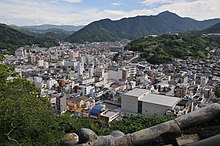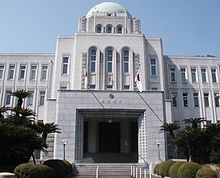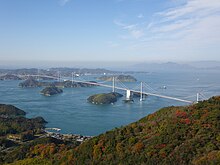Ehime Prefecture
 From Wikipedia - Reading time: 12 min
From Wikipedia - Reading time: 12 min
This article needs additional citations for verification. (October 2018) |
Ehime Prefecture
愛媛県 | |
|---|---|
| Japanese transcription(s) | |
| • Japanese | 愛媛県 |
| • Rōmaji | Ehime-ken |
View of the Mount Ishizuchi Uwajima Tensya Garden Besshi copper mine heritage site Shikoku Karst (Godan Plateau) | |
| Anthem: Ehime no uta | |
 | |
| Coordinates: 33°50′N 132°50′E / 33.833°N 132.833°E | |
| Country | Japan |
| Region | Shikoku |
| Island | Shikoku |
| Capital | Matsuyama |
| Subdivisions | Districts: 7, Municipalities: 20 |
| Government | |
| • Governor | Tokihiro Nakamura (since December 2010) |
| Area | |
• Total | 5,676.23 km2 (2,191.60 sq mi) |
| • Rank | 26th |
| Population (October 1, 2020) | |
• Total | 1,334,841 |
| • Rank | 28th |
| • Density | 240/km2 (610/sq mi) |
| GDP | |
| • Total | JP¥5,148 billion US$47.2 billion (2019) |
| ISO 3166 code | JP-38 |
| Website | www |
| Symbols of Japan | |
| Bird | Japanese robin (Erithacus akahige)[2] |
| Fish | Red sea bream (Pagrus major)[2] |
| Flower | Satsuma mandarin (Citrus unshiu)[2] |
| Mammal | Japanese river otter ("Lutra lutra whiteleyi")[2][3] |
| Tree | Pine (Pinus)[2] |
Ehime Prefecture (愛媛県, Ehime-ken) is a prefecture of Japan located on the island of Shikoku.[4] Ehime Prefecture has a population of 1,334,841[5] and has a geographic area of 5,676 km2 (2,191 sq mi). Ehime Prefecture borders Kagawa Prefecture to the northeast, Tokushima Prefecture to the east, and Kōchi Prefecture to the southeast.
Matsuyama is the capital and largest city of Ehime Prefecture and the largest city on Shikoku, with other major cities including Imabari, Niihama, and Saijō.[6]
Notable past Ehime residents include three Nobel Prize winners: they are Kenzaburo Oe (1994 Nobel Prize in Literature), Shuji Nakamura (2014 Nobel Prize in Physics), and Syukuro Manabe (2021 Nobel Prize in Physics).
History
[edit]Until the Meiji Restoration, Ehime Prefecture was known as Iyo Province.[7] Since before the Heian period, the area was dominated by fishermen and sailors who played an important role in defending Japan against pirates and Mongolian invasions.
After the Battle of Sekigahara, the Tokugawa shōgun gave the area to his allies, including Katō Yoshiaki who built Matsuyama Castle, forming the basis for the modern city of Matsuyama.
The name Ehime comes from the kuniumi part of the Kojiki where Iyo Province is mythologically named Ehime, "lovely princess".[8]
In 2012, a research group from the University of Tokyo and Ehime University said they had discovered rare earth deposits in Matsuyama.[9]
Geography
[edit]Located in the northwestern part of Shikoku, Ehime faces the Seto Inland Sea to the north and is bordered by Kagawa and Tokushima in the east and Kōchi in the south.
The prefecture includes both high mountains in the inland region and a long coastline, with many islands in the Seto Inland Sea. The westernmost arm of Ehime, the Sadamisaki Peninsula, is the narrowest peninsula in Japan.
As of 31 March 2020, 7 percent of the total land area of the prefecture was designated as Natural Parks, namely the Ashizuri-Uwakai and Setonaikai National Parks; Ishizuchi Quasi-National Park; and Hijikawa, Kinshako, Okudōgo Tamagawa, Sadamisaki Hantō-Uwakai, Saragamine Renpō, Sasayama, and Shikoku Karst Prefectural Natural Parks.[10]
Cities
[edit]

City Town



Eleven cities are located in Ehime Prefecture:
| Name | Area (km2) | Population (2020)[11] | Map | |
|---|---|---|---|---|
| Rōmaji | Kanji | |||
| 今治市 | 419.56 | 151,672 | 
| |
| 伊予市 | 194.44 | 35,133 | 
| |
| 松山市 | 429.4 | 511,192 | 
| |
| 新居浜市 | 234.3 | 115,938 | 
| |
| 大洲市 | 432.24 | 40,575 | 
| |
| 西条市 | 509.07 | 104,791 | 
| |
| 西予市 | 514.78 | 35,388 | 
| |
| 四国中央市 | 421.24 | 82,754 | 
| |
| 東温市 | 211.45 | 33,903 | 
| |
| 宇和島市 | 469.48 | 70,809 | 
| |
| 八幡浜市 | 133.03 | 31,987 | 
| |
Towns and villages
[edit]These are the towns in each district:
| Name | Area (km2) | Population (2020)[12] | District | Map | |
|---|---|---|---|---|---|
| Rōmaji | Kanji | ||||
| 愛南町 | 239.58 | 19,601 | Minamiuwa District | 
| |
| 伊方町 | 94.37 | 8,397 | Nishiuwa District | 
| |
| 上島町 | 30.38 | 6,509 | Ochi District | 
| |
| 鬼北町 | 241.87 | 9,682 | Kitauwa District | 
| |
| 久万高原町 | 583.66 | 7,404 | Kamiukena District | 
| |
| 松前町 | 20.41 | 29,630 | Iyo District | 
| |
| 松野町 | 98.5 | 3,674 | Kitauwa District | 
| |
| 砥部町 | 101.57 | 20,480 | Iyo District | 
| |
| 内子町 | 299.5 | 15,322 | Kita District | 
| |
Mergers
[edit]Former districts:
- Onsen District
- Shūsō District
- Uma District
- Uwa District (historical)
Economy
[edit]The coastal areas around Imabari and Saijō host a number of industries, including dockyards of Japan's largest shipbuilder, Imabari Shipbuilding. Chemical industries, oil refining, paper and cotton textile products also are a feature of the prefecture. Rural areas mostly engage in agricultural and fishing industries, and are particularly known for citrus fruits such as mikan (mandarin orange), iyokan and cultured pearls.
Ikata Nuclear Power Plant produces a large portion of Shikoku Electric Power.[citation needed]
Education
[edit]Universities and colleges
[edit]National
[edit]Prefectural
[edit]Private
[edit]Senior high schools
[edit]Prefectural
[edit]Sports
[edit]
The sports teams listed below are based in Ehime.
Association football:
Baseball:
Basketball:
Culture
[edit]The oldest extant hot spring in Japan, Dōgo Onsen, is located in Matsuyama. It has been used for over two thousand years.
These are television shows and movies set in Ehime Prefecture.
- Tokyo Love Story is a story with characters are from Ehime Prefecture. Therefore, a lot of shooting was done in Ehime. Baishinji Station is famous for being filmed.
- Shodō Girls was made based on the true story of a high school student in Shikokuchūō. A member of the calligraphy club began doing Performance calligraphy at shopping malls and events to liven up the local region. After that, the Shodō Performance Koshien (書道パフォーマンス甲子園) was held in 2008.
- Botchan is a novel written by Natsume Sōseki. It was based on his experience in Matsuyama. Movies, dramas, and manga are published based on the novel. Botchan Ressha and Botchan Stadium are associated with this.
- Saka no Ue no Kumo is written by Ryōtarō Shiba. The main characters are Akiyama Yoshifuru, Akiyama Saneyuki and Masaoka Shiki, all of whom are from Ehime prefecture. It was broadcast on NHK as a TV drama.
- Koi wa Go・Hichi・Go! (恋は五・七・五!) is set in Haiku Koshien, which is actually performed. The shooting was done at a high school, university, and library in Ehime. The haiku of this movie was supervised by Itsuki Natsui, haiku poet from Ehime.
- Destruction Babies (ディストラクション・ベイビーズ) is set in Ehime. This movie was made based on the true story that the director head from a person he met when he visited Matsuyama. The director won an award at the Locarno Festival in 2016, and the film was selected as semi-grand prix at the Three Continents Festival in 2016.
- My-HiME is set in Ehime.
There are major festivals in Ehime Prefecture.
- Uwajima Ushi-oni Festival is held for three days, with a parade of many Ushi-oni walking around the city, a traditional Uwajima dance, a fireworks display, and a run on the final day.
- Niihama Taiko Festival is the autumn festival in Niihama. The drum stand is lifted by about 150 men. It is one of the three biggest fight festivals in Japan.
- The Matsuyama Autumn Festival includes a mikoshi event called Hachiawase (鉢合わせ) which takes place near Dōgo Onsen and Isaniwa Shrine.
Hot springs
[edit]These are several hot springs (onsen) in Ehime Prefecture.
- Dōgo Onsen appears in the Nihon Shoki. This Hot Spring has three public baths: the main building, Tsubaki no Yu, and Asuka no Yu.
- Sora to Mori is a combined warm bath facility. There are hot springs, restaurants, and body care.
- Nibukawa Onsen is a hot spring located in Imabari. The source originates from the crevices of the Inugawa Valley in this hot spring town.
Language
[edit]Iyo dialect is a Japanese dialect spoken in Ehime Prefecture. Nanyo is influenced by the Kyushu dialect, and Chuyo and Toyo are influenced by the Kinki dialect.
Museums
[edit]Transport
[edit]
Railway
[edit]- Shikoku Railway (JR Shikoku)
- Iyo Railway (Iyotetsu)
- Gunchū Line
- Takahama Line
- Yokogawara Line
- Matsuyama Inner Line
Road
[edit]Expressway
[edit] Matsuyama Expressway
Matsuyama Expressway Tokushima Expressway
Tokushima Expressway Takamatsu Expressway
Takamatsu Expressway Kōchi Expressway
Kōchi Expressway Nishiseto Expressway (also referred to as the Shimanami Kaidō)
Nishiseto Expressway (also referred to as the Shimanami Kaidō) Imabari-Komatsu Expressway
Imabari-Komatsu Expressway
National highways
[edit] National Route 11
National Route 11 National Route 33 (Matsuyama-Kōchi)
National Route 33 (Matsuyama-Kōchi) National Route 56 (Matsuyama-Iyo-Uwajima-Sukumo-Susaki-Kōchi)
National Route 56 (Matsuyama-Iyo-Uwajima-Sukumo-Susaki-Kōchi) National Route 192 (Saijyo-Shikokuchūō-Yoshinogawa-Tokushima)
National Route 192 (Saijyo-Shikokuchūō-Yoshinogawa-Tokushima) National Route 194
National Route 194 National Route 196
National Route 196 National Route 197
National Route 197 National Route 317 (Matsuyama-Imabari-Onomichi)
National Route 317 (Matsuyama-Imabari-Onomichi) National Route 319
National Route 319 National Route 320
National Route 320 National Route 378
National Route 378 National Route 380
National Route 380 National Route 437
National Route 437 National Route 440
National Route 440 National Route 441
National Route 441 National Route 494 (Matsuyama-Niyodogawa-Susaki)
National Route 494 (Matsuyama-Niyodogawa-Susaki)
Ports
[edit]- Kawanoe Port
- Niihama Port - Ferry route to Osaka
- Toyo Port - Ferry route to Osaka
- Imabari Port - Ferry route to Innoshima, Hakata Island, and international container hub port
- Matsuyama Port - Ferry route to Kitakyushu, Yanai, Hiroshima, Kure, and international container hub port
- Yawatahama Port - Ferry route to Beppu, Usuki
- Misaki Port - Ferry route to Oita
- Uwajima Port
Airport
[edit]Notable people
[edit]- Naoki Kuwata (born 1977), actor and model
- Tetchō Suehiro (born 1849), politician, novelist and journalist
International relations
[edit]Ehime Prefecture is making use of its long tradition of involvement with people overseas through international exchanges in areas such as the economy, culture, sports and education.[13]
 British Columbia, Canada
British Columbia, Canada Dalian, China
Dalian, China Hawaii, United States
Hawaii, United States Liaoning, China
Liaoning, China New South Wales, Australia
New South Wales, Australia Queensland, Australia
Queensland, Australia
Notes
[edit]- ^ "2020年度国民経済計算(2015年基準・2008SNA) : 経済社会総合研究所 - 内閣府". 内閣府ホームページ (in Japanese). Retrieved 2023-05-18.
- ^ a b c d e 愛媛県の紹介 > 愛媛県のシンボル. Ehime prefectural website (in Japanese). Ehime Prefecture. Archived from the original on 9 January 2008. Retrieved 9 September 2011.
- ^ "Japanese River Otter Facts".
- ^ Nussbaum, Louis-Frédéric. (2005). "Ehime" in Japan Encyclopedia, p. 170, p. 170, at Google Books.
- ^ "Ehime Population".
- ^ Nussbaum, "Matsuyama" at p. 621, p. 621, at Google Books.
- ^ Nussbaum, "Provinces and prefectures" at p. 780, p. 780, at Google Books.
- ^ Chamberlain, Basil Hall. 1882. A translation of the "Ko-ji-ki" or Records of ancient matters. section V
- ^ "Japan Discovers Domestic Rare Earths Reserve". BrightWire. Archived from the original on 2012-07-23. Retrieved 2012-05-10.
- ^ 自然公園都道府県別面積総括 [General overview of area figures for Natural Parks by prefecture] (PDF) (in Japanese). Ministry of the Environment. 31 March 2020. Retrieved 23 September 2020.
- ^ "Ehime Population".
- ^ "Ehime Population".
- ^ "International exchange activated with globalization". Ehime Prefecture. Retrieved 2018-10-27.
References
[edit]- Nussbaum, Louis-Frédéric and Käthe Roth. (2005). Japan encyclopedia. Cambridge: Harvard University Press. ISBN 978-0-674-01753-5; OCLC 58053128
 KSF
KSF







